#1002 Clouds Over Tharsis on Mars March 17, 1998

“When and where do clouds form on Mars? The Mars Global Surveyor spacecraft currently orbiting Mars is finding out. Photographs released last week showed clouds forming above Tharsis, a huge bulge on Mars about 4000 kilometers across and 7 kilometers high containing several large volcanoes. These clouds temporarily disappeared as a large dust storm emerged from the South, the first developing dust storm to be tracked by an orbiting spacecraft. Mars Global Surveyor continues to aerobrake during on its ongoing mission to survey the planet Mars."
Copyright: Public domain
#1003 Interstellar Dust-Bunnies of NGC 891 March 18, 1998

“What is going on in NGC 891? This galaxy appeared previously to be very similar to our own Milky Way Galaxy: a spiral galaxy seen nearly edge-on. However, recent high-resolution images of NGC 891's dust show unusual filamentary patterns extending well away from its Galactic disk. This interstellar dust was probably thrown out of the galactic disk toward the halo by stellar supernovae explosions. Because dust is so fragile, its appearance after surviving disk expulsion can be very telling. Newly discovered phenomena, however, sometimes appear so complex that more questions are raised than are answered."
Copyright: WIYNWIYN Telescope
#1004 Mars: A Canyon's Edge March 19, 1998
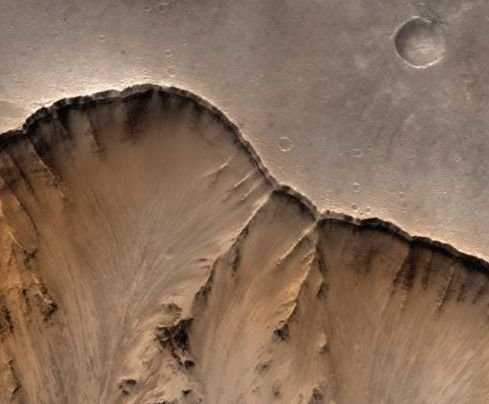
“High resolution Mars Global Surveyor images were combined with Viking Orbiter color data to produce this stunning, detailed view of a Martian canyon's edge. The area pictured is about 6 miles wide and represents a tiny part of the northern edge of the canyon Valles Marineris, whose total length is about 2,500 miles. Details 20 to 30 feet across can be seen in the high resolution data. The composition of the thin, well-defined layers in the steep canyon walls is unknown, but their presence points to a complex and active Martian geologic history. In the later half of the 1970s, NASA's Viking Orbiters photographed Mars extensively, yet Surveyor's sharp new images have produced some striking and unanticipated results."
Copyright: Public domain
#1005 Mars: Ridges Near The South Pole March 20, 1998
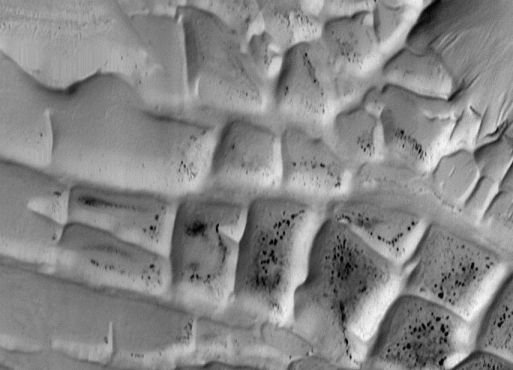
“No, it's not breakfast ... but looking down from an orbiting spacecraft, the odd intersecting ridges covering this area of Mars do present a waffle-like appearance. The cause of the ridge pattern is unknown but it suggests that more complex layered deposits lie below. The south polar region in this Mars Global Surveyor image measures about 8.5 by 12 miles and is spread with a layer of bright, seasonal carbon dioxide frost. Mysterious dark spots which pepper some of the interridge areas are 60 to 300 feet across. Their exact nature is also unknown, but these spots have apparently defrosted early and lack the bright layer of frozen carbon dioxide."
Copyright: Public domain
#1006 The Gamma Ray Sky March 21, 1998
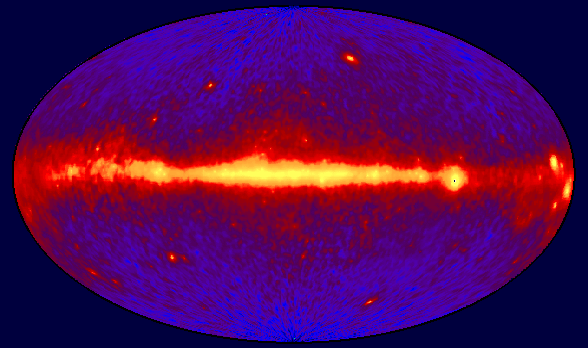
“What if you could "see" gamma rays? If you could, the sky would seem to be filled with a shimmering high-energy glow from the most exotic and mysterious objects in the Universe. In the early 1990s NASA's orbiting Compton Observatory, produced this premier vista of the entire sky in gamma rays - photons with more than 40 million times the energy of visible light. The diffuse gamma-ray glow from the plane of our Milky Way Galaxy runs horizontally through the false color image. The brightest spots in the galactic plane (right of center) are pulsars - spinning magnetized neutron stars formed in the violent crucibles of stellar explosions. Above and below the plane, quasars, believed to be powered by supermassive black holes, produce gamma-ray beacons at the edges of the universe. The nature of many of the fainter sources remains unknown."
Copyright: Public domain
#1007 Sunspots: Magnetic Depressions March 22, 1998
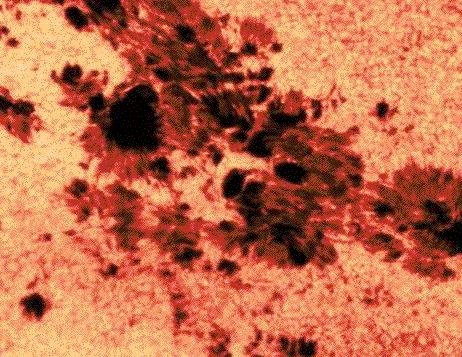
“Our Sun has spots! These spots appear dark in photographs like the one above, but in fact sunspots are quite bright - they are just dark compared to the rest of the Sun. Sunspots are about the size of the Earth and frequently occur in groups, as shown above. Sunspots occur when a concentrated portion of the Solar magnetic field pokes through the surface. This field slows energy from entering the sunspot region, causing sunspots to appear cooler, darker, and lower than the surrounding surface. Sunspots typically last a few days before dissipating. The number of sunspots is always changing, generally going from a maximum to a minimum about every 5 ½ years. In fact, the Sun just passed a minimum two years ago. The Sun and sunspots should never be looked at directly."
Copyright: Public domain
#1008 Starbirth in NGC 1808 March 23, 1998
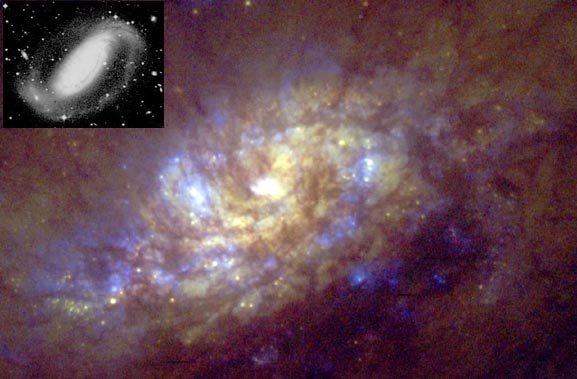
“The center of galaxy NGC 1808 is bursting with new stars, but why? Being a barred spiral galaxy makes NGC 1808 somewhat similar to our own Milky Way Galaxy. But the disk of NGC 1808 (inset) is quite warped, and its center is unusually bright and blue. The above picture of NGC 1808's center, in representative color, was recently taken by the Hubble Space Telescope and released yesterday. Perhaps gravitational pull from a recent pass of neighboring galaxy NGC 1792 has caused matter to move inward along NGC 1808's bar, triggering the burst of star formation. Also prominent are blue clusters of stars and filaments of dark dust obscuring even more activity."
Copyright: Public domain
#1009 A Baby Galaxy March 24, 1998
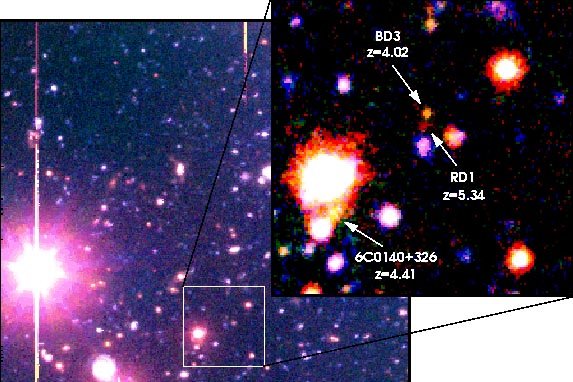
“What's the farthest galaxy known? The answer keeps changing as astronomers compete to find new galaxies which top the list. The new record holder is now the faint red smudge indicated in the above image by the arrow. Detected light left this galaxy billions of years ago, well before the Earth formed, when the universe was younger than 1/10th of its present age. Astronomers have measured a redshift of 5.34 for this galaxy, breaking the "5 barrier" for the first time. Young galaxies are of much interest to astronomers because many unanswered questions exist on when and how galaxies formed in the early universe. Although this galaxy's distance exceeds that of even the farthest known quasar, it is still in front of the pervasive glowing gas that is now seen as the cosmic microwave background radiation."
Copyright: Public domain
Upvote! Resteem! Comment! As you like it! Thank you for attention!
We are reached 1000 apod posts and no asteroid destroyed our Earht!!!!!!! Congratulations!
Downvoting a post can decrease pending rewards and make it less visible. Common reasons:
Submit